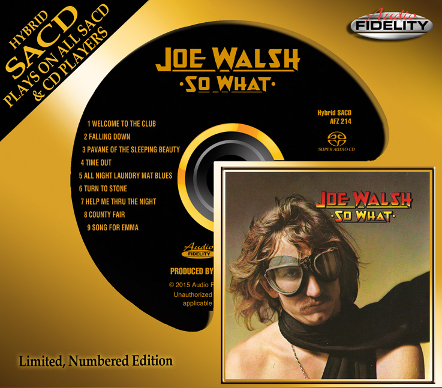Is Mastering Important? Part 3
I've got a punch list of albums from my history that I considered really well-engineered. Years ago when I became a recording engineer I was going to contact the original engineers who recorded these albums and see if I could cop a "professional interest" dub of them in order to really get a chance to hear them like the original engineers did. On my short list were several albums engineered by Bill Szymczyk, the producer/engineer who signed Joe Walsh and ended up producing his albums for many years. Near the top of my list were Joe's The Smoker You Drink the Player You Get from 1973 and So What? from 1974, albums that hit me musically at a really formative phase in my guitar playing and and also piqued my engineering interest. But once I got settled in my job and started mixing I got so busy I ended up submerged in the studio for nearly a decade and never got around to I asking for those copies. Finally, some thirty-some-odd years later, the Audio Fidelity remasters are allowing me to check them off my list, one by one. The first was The Smoker You Drink the Player You Get, which came out two years ago. The second was Joe Walsh's next album, So What?

So recently, the day that Audio Fidelity's remaster of So What? dropped in the stores, I ordered my my copy from Amazon and then spent a couple of days waiting on the U.S. Mail with baited breath. This was an album I am intimately familiar with. I played the grooves off of this album learning the guitar parts when it came out. I spent affternnons lying on my bed listening with the headphones on. I can tell you exactly where I first heard it - in the loft of my drummer's apartment in West Knoxville, Tennessee, after he returned from a visit to Texas. This would have been my senior year in high school. I still have my vinyl copy with the embossed inner record sleeve. The afternoon the package showed up in my mailbox I dived in, first giving it a thorough listen from front to back and then going track by track. And finally, I compared the SACD layer to the CD layer. The results?
The positives? The whole album is now cleaned up, clear, noiseless. I could be wrong but it sounds like the Audio Fidelity guys are using some excellent noise reduction software, and applying it very well. As usual, they went back to the original master. I could only detect the slightest bit of noise in a fadeout or two and that is outstanding. Mastering engineer Kevin Gray tamed the raucous cymbals and crashy high-end from the MCA release, found the bass, and made space for an open midrange. The overall effect is a more cohesive album, mixes that makes sense. And the mastering is very, very smooth-sounding.
Let's talk about the SACD layer first: The mastering and noise control have restored the depth and the spaciousness of this album. This album is atmospheric enough that it needs its depth, it needs a sense of three-dimensional physical space. The SACD does exactly that, revealing a broad and deep soundstage. I was waiting to hear the acoustic guitars, and Kevin brought them out the way Bill Szymczyk always did, crisp and present but smooth-sounding. I was waiting for the pipe organ at the end of "Turn to Stone" to arrive and was well-rewarded with a wide-range sound including really low-lows that kicked the subwoofers just right without being overblown. Bravo. And thanks to Father Jas. McKeown for the use of the organ. I was wondering what would happen to what is probably Joe's most "open" arrangement, "County Fair," with a whole bunch of ambience, both forwards and backwards. This is the sort of song that can give a restoration engineer fits because it can reveal the source's noise floor. Kevin's mastering gives the song clean space to breathe. And then there's Joe's poignant ode to his daughter who died that year in an auto accident, "Song for Emma," with its lush strings recorded by Szymczyk at Criterion Studios in Miami. Finally, finally, the song is done justice. On the record it was largely lost in inner-groove distortion. On the MCA CD the mix didn't feel cohesive and smooth and the quiet passages and end were awah in hiss. This version brings it all together, with a fadeout that lasts forever, fading into silence. Overall, there is balance: the highs are crisp without being sharp and the bass is round without being flabby.

How about the CD layer? It appears to simply be a bit more compressed than the SACD layer. The sense of physical depth is a little less evident and the whole mix feels a little more forward and present, but that's exactly what you expect with the lower bit rate. It is still very pleasant as a portable source on your iPad or iPhone.
Kudos to Kevin Gray and Audio Fidelity for bringing me back into a musical space I haven't been able to enter for over thirty years, and for a great job mastering this great album into a medium that allows us to hear it shine like we never heard before, starting forty years ago.

AUDIO FIDELITY WEBSITE
= =
=



